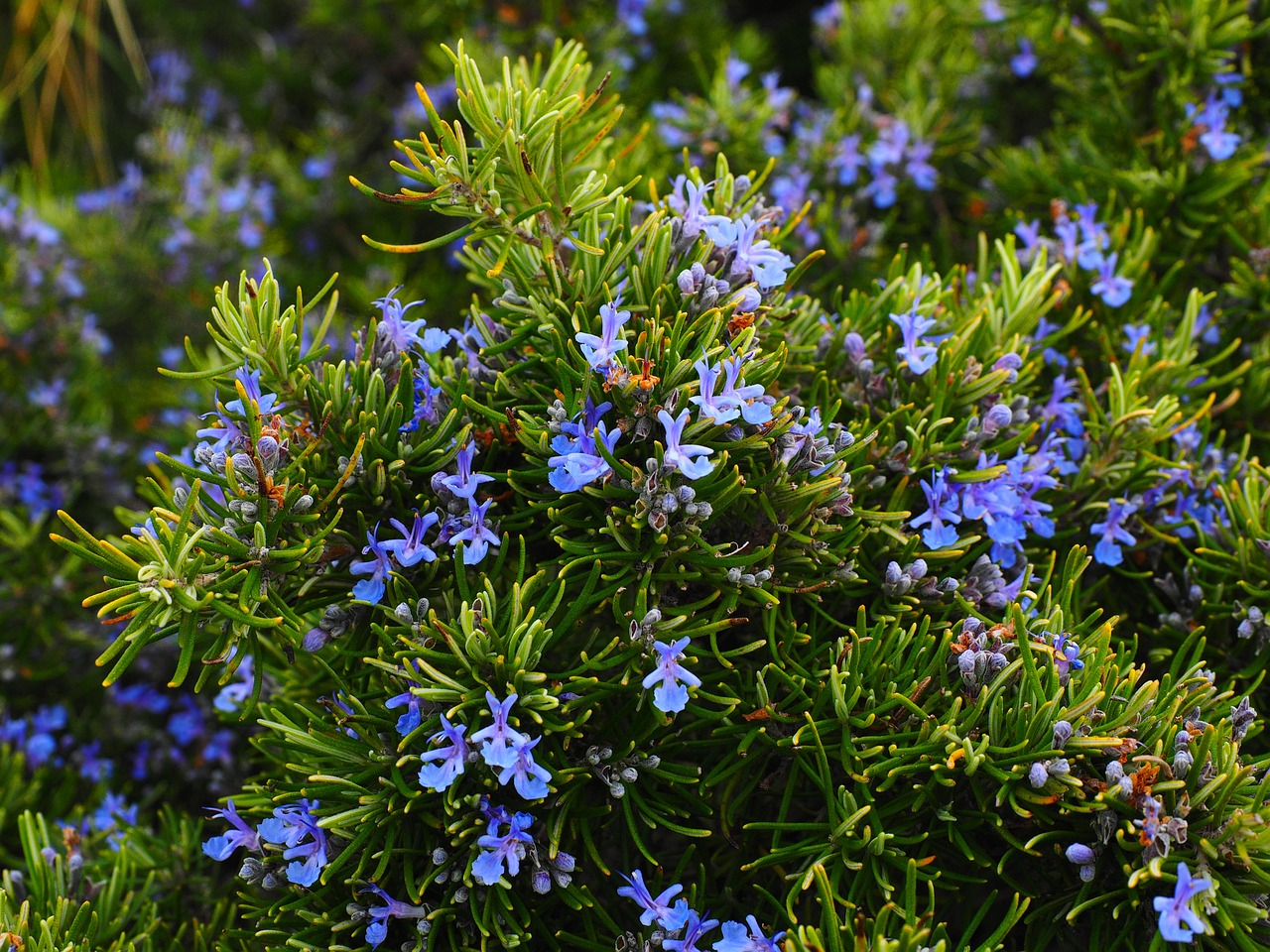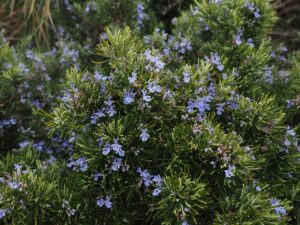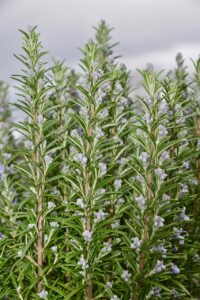Rosemary
Overview
Rosemary, also known as *Salvia rosmarinus*, is a beloved woody shrub cherished for its aromatic needle-like foliage. It is an evergreen that flourishes in sunny, Mediterranean conditions, offering culinary and ornamental delights. With its low-maintenance nature and striking blue to white flowers, rosemary is a valuable addition to any garden, inviting in a buzz of pollinators and standing sturdy year-round.

Characteristics
Known for its needle-like gray-green leaves, woody stems, and fragrant culinary and ornamental uses, including its ability to attract pollinators with its colorful flowers.
Region
Mediterranean climates.
Natural Habitat
Typically found in the wild on dry, rocky hillsides and coastal areas.
Cultivation
Requires full sun exposure, occasional watering once established, and prefers well-drained soil.
Uses and Benefits
Rosemary, with its heavenly scent and robust flavor, is a chef’s delight and a gardener’s treasure. Not just for adding zest to culinary creations, this herb is celebrated for its decorative appeal too—think of its pretty little flowers that come in hues from blue to white, jazzing up both gardens and dishes.
It’s not all about looks and taste though; rosemary holds a secret power—it’s a magnet for friendly pollinators providing a hub for biodiversity right in your backyard. Grown from cuttings rather than seeds, this resilient shrub keeps things simple for the green thumb enthusiast. Given its love for sunshine and well-drained soils, rosemary thrives without much fuss, promising lush greenery and aromatic leaves year-round1.
But the benefits of rosemary extend far beyond its culinary and aesthetic charm. This herb is a true powerhouse when it comes to health and wellness. Rosemary is packed with antioxidants and anti-inflammatory compounds, making it a natural ally in fighting off free radicals and reducing inflammation in the body2.
In the kitchen, rosemary’s uses are virtually endless. Its assertive flavor pairs beautifully with a wide range of dishes, from savory roasts and stews to delicate baked goods and refreshing beverages. Rosmarinus officinalis is not just a one-trick pony; its versatility is truly impressive.
Beyond its culinary prowess, rosemary has a long history of use in traditional medicine. Its essential oil is known for its stimulating and rejuvenating properties, making it a popular choice for aromatherapy and natural remedies. Whether used in a soothing massage oil or added to a relaxing bath, rosemary can help ease tension, improve circulation, and promote an overall sense of well-being3.
So, whether you’re a seasoned chef, a nature lover, or simply someone looking to add a touch of beauty and wellness to your life, rosemary is a must-have herb. Its hardy nature, attractive appearance, and wealth of benefits make it a true garden gem that keeps on giving.

Cultivation Tips
To successfully cultivate Rosemary, begin with a young plant or cutting since starting from seed can be quite challenging1. Ensure you plant your Rosemary in a sunny spot with well-drained soil; it loves basking in full sunlight. Be mindful of spacing, as Rosemary needs room to expand, generally up to 3 feet in height and 4 feet in width.
Keep the soil moist, but be careful not to overwater – Rosemary dislikes soggy feet and could succumb to root rot if left too damp2. Follow these tips for optimal growth:
- Plant in a location that receives at least 6 hours of direct sunlight daily
- Use a well-draining potting mix or amend garden soil with sand or perlite
- Water deeply but infrequently, allowing the soil to dry out between watering sessions
- Prune regularly to maintain shape and promote bushiness
- Protect from harsh winter conditions by mulching or bringing potted plants indoors
As a perennial, this herb will grace your garden year-round and produce delicate and beneficial flowers most abundantly in late spring and early summer. Remember, patience and a watchful eye on watering can yield a bushy, fragrant, and robust Rosemary shrub.
Seasonal Considerations
When it comes to seasonal considerations for Rosemary (Salvia rosmarinus), it’s important to remember that this hardy herb thrives in full sun and well-draining soil. In most regions, Rosemary can be planted outdoors in the spring after the risk of frost has passed.
During the summer months, Rosemary will flourish with minimal care. It’s drought-tolerant and can handle the heat, but be sure to water it regularly during extended dry spells. In late spring and early summer, you’ll be rewarded with delicate, blue, pink, or white flowers that attract bees and other pollinators to your garden.
As temperatures drop in the fall, Rosemary proves its resilience. It can withstand light frosts, but in colder climates, it’s best to protect your plant by:
- Mulching heavily around the base of the plant
- Covering it with frost cloth during cold snaps
- Moving potted Rosemary plants to a sheltered location or indoors
In winter, Rosemary growth slows down, but the plant remains evergreen. If you live in a region with harsh winters, it’s essential to shield your Rosemary from icy winds and freezing temperatures. Container-grown Rosemary should be brought inside and placed near a sunny window to ensure its survival until spring returns.
With its year-round appeal and adaptability, Rosemary makes a wonderful addition to any garden. By understanding its seasonal needs and providing the right care, you’ll enjoy this fragrant herb’s beauty and flavor for years to come.

Issues and Troubleshooting
Maintaining the health of your Rosemary plant can be a bit tricky, but most problems often stem from a few fixable issues. The most common misstep is overwatering, which this drought-tolerant herb doesn’t take kindly to. Excess moisture can lead to root rot, so if you notice any of these signs, it’s time to take action:
- Leaves turning brown or black
- Plant losing its vigor and looking unhealthy
If you spot these symptoms, reassess your watering schedule immediately. Ensuring the soil around your Rosemary is well-drained will do wonders for its health. Here are a few tips to help:
- Allow the soil to dry out between waterings
- Plant Rosemary in a pot with drainage holes
- Use a well-draining potting mix, such as one containing perlite or sand
Keep a close watch on your plant and adjust care accordingly; a bit of diligence goes a long way in keeping this fragrant, evergreen shrub thriving2.
History and Folklore
Steeped in history and wrapped in folklore, rosemary is a herb that whispers tales of the ancient world. It was considered sacred to the Egyptians, Romans, and Greeks, who associated it with memory and fidelity.
In medieval times, rosemary was intertwined with wedding ceremonies, symbolizing love and loyalty. It was believed that if a bride carried a sprig of rosemary, it would bring happiness to the couple. This tradition has endured through the ages, with many modern brides incorporating rosemary into their bouquets or decorations.
During the Plague, it was customary to wear rosemary to ward off the deadly disease, signifying its role as a protective charm. People believed that the herb’s strong scent could prevent the spread of the illness and protect them from harm.
This rich aromatic herb, transcending its culinary distinction, has been a steady emblem of remembrance and protection throughout the annals of time1. Its legacy lives on in literature, art, and the hearts of those who appreciate its enduring symbolism.
References
1. Growing Guide for Rosemary: Plant Care Tips, Varieties, and More, https://www.treehugger.com/growing-guide-rosemary-5203689
2. Rosemary: Planting, Growing, and Harvesting Rosemary Plants, https://www.almanac.com/plant/rosemary
3. How to Plant and Grow Rosemary, https://www.bhg.com/gardening/plant-dictionary/herb/rosemary/
4. How to Plant, Grow and Care For Rosemary, https://www.epicgardening.com/growing-rosemary/
5. How to Grow and Care for Rosemary, https://www.thespruce.com/grow-and-care-for-rosemary-plants-1403406
Nicolas Duval
Nicolas is a passionate advocate for nature and the art of wildcrafting. His dedication shines through in Wildcraftia, a website he meticulously crafted to serve as a haven for nature enthusiasts worldwide. Driven by a deep appreciation for nature’s connection to humanity, Nicolas embarked on his journey in 2011 with SmokableHerbs, a platform showcasing his love for nature’s bounty. Building upon this foundation, he established Smokably, a thriving online store offering premium herbs and blends to a global audience.
